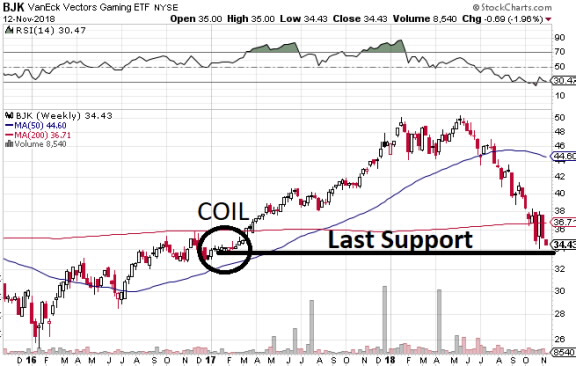After yesterday’s selloff in the S&P 500, there should be no further doubt that we are at the beginning stages of a bear market in equities. Yesterday was the third biggest one-day loss in the S&P since stocks topped on September 21st, the autumn equinox, AKA the end of the summer and the beginning of the fall, pun intended. (The equinox was technically September 23rd, but there was no trading as it was a Sunday.) The ominous sign yesterday was that the index fell back below its 200 day moving average, after attempting to regain it after last week’s really. The Nasdaq already fell through its 200DMA on Friday. The canary gaming sector fell through that level a long time ago on July 2nd, with a “death cross” on August 9th, when the 50DMA crosses below the 200DMA.
Another interesting technical sign that emphasizes the leading role of gaming equities: The 50 week moving average in the BJK gaming ETF began to fall almost exactly as the S&P 500 topped. We can be fairly confident that the fall is not over because BJK is now decisively below its 200 week moving average. After bouncing higher off its 200WMA on the week of October 15th, it broke up above it again the next week, making traders think that we were bottoming. But then it decisively broke back below the week of October 29th, and continued down the first week of November, finally closing decisively lower again this past week. You can see the war being waged between bulls and bears at the very end of this weekly chart, the 200WMA being the front lines.

The final line in the sand in gaming equities, particularly Macau stocks, is 2-year support at $33.80. This was the jump-off point for the final 50% push to May highs. Notice above (in this expertly annotated chart using state-of-the-art MS Paint technology), how at the beginning of 2017, gaming stocks coiled tightly for two months before jumping higher at the end of February last year. Break down through that coil and the next support is at about $30, about 13% lower from where we are now.
 Gaming has led the S&P 500 and bottomed together with it since the financial crisis of 2008. We should not expect that to change this time around. Gaming began to seriously crash in January 2008, the broader market in September, but both bottomed together in March 2009, the upswing led by gaming. Both bottomed together in October 2011, same story. The only anomaly was the Macau collapse of 2014 which was not accompanied by a broader market decline because the Macau collapse was political in nature and not business-cycle related. Nevertheless both bottomed nearly together, about 3 weeks apart in early 2016. This is not just a coincidence. There are fundamental reasons for it. As central banks tighten credit after a prolonged liquidity punch-drunk boom, the first industries to feel the pinch are recreational, and the rot spreads from there.
Gaming has led the S&P 500 and bottomed together with it since the financial crisis of 2008. We should not expect that to change this time around. Gaming began to seriously crash in January 2008, the broader market in September, but both bottomed together in March 2009, the upswing led by gaming. Both bottomed together in October 2011, same story. The only anomaly was the Macau collapse of 2014 which was not accompanied by a broader market decline because the Macau collapse was political in nature and not business-cycle related. Nevertheless both bottomed nearly together, about 3 weeks apart in early 2016. This is not just a coincidence. There are fundamental reasons for it. As central banks tighten credit after a prolonged liquidity punch-drunk boom, the first industries to feel the pinch are recreational, and the rot spreads from there.
We are just at the beginning here. While gaming has already crashed through its 200WMA, the broader market is not even close. Broader indexes are working on the daily moving averages, only just now flirting with falling below the 50 weekly. The 50 weekly is only now starting to flatten for the first time in two and a half years, and the 200 is still a record distance above the 50 since the very beginning of this global bull market in March 2009. There is still plenty of room to fall.
But this is all just charting. Charting doesn’t prove much by itself. The proof of the pudding is in the supply of the world’s reserve currency, and boy is that in a sorry state. Check the very bottom right corner at the mini-table under table 2 at this link and you’ll see the annual M2 growth rate at only 3.9%. That is the lowest annual growth for this time of year the second week of November since 2010. Remember that in 2010 stocks were well below their highs. Now they’re not.
This time of year is seasonally the strongest for the dollar supply, and we are just not seeing that this year at all. By next summer during the seasonal dip we should be in a real serious liquidity crunch considering we’re going to be dipping down from these already anemic levels. Central banks should be forced to respond by the spring or summer of 2019 at the latest. Once that happens, it’ll be time to buy back in. It will result in a nominal burst higher in equities, but currency markets and bond markets will fall amid galloping inflation and debt crises.
The general strategy here for conservative traders should be to continue to scale out on up days. If you’ve been following this column and you’ve already finished doing that and you’re up for a little more risk, there are two general shorting strategies to consider without risking too much capital. First, you could reserve a little bit of money for medium-expiration put options on BJK or individual Macau stocks like LVS, Wynn, Melco, or MGM on strong up days. Emphasis on a little bit in case central banks surprise and act earlier than expected. Expirations should go out a few months for a decent buffer to account for the risk of strong bear market rallies. When you’re up, cover, wait for the next strong up day, rinse and repeat.
Second, you can play the long game with puts going out to 2020 and just keep them as a hedge throughout next year. Or you can do a combination of both.